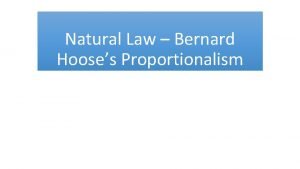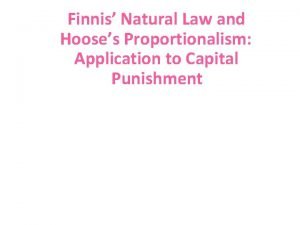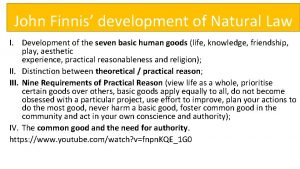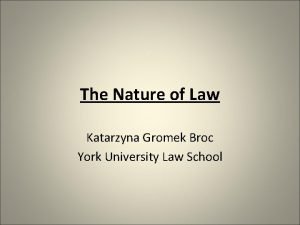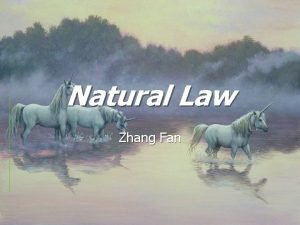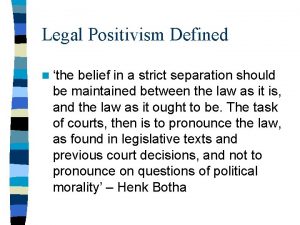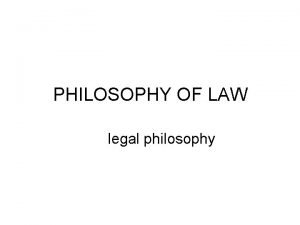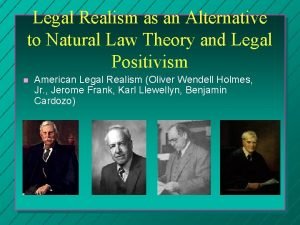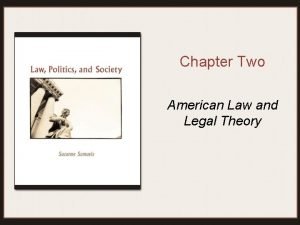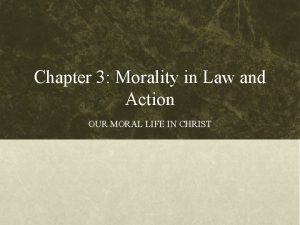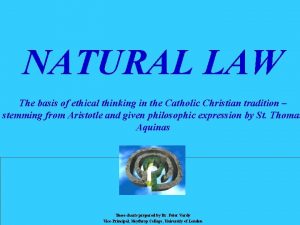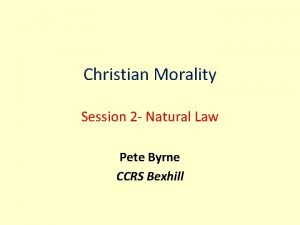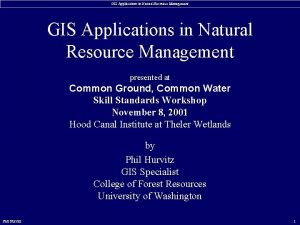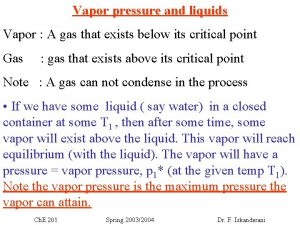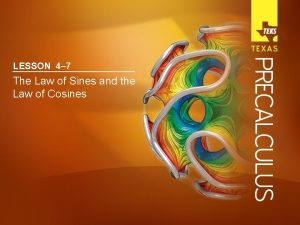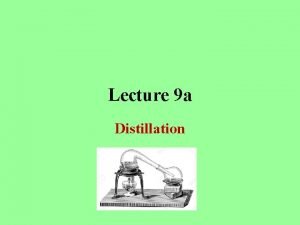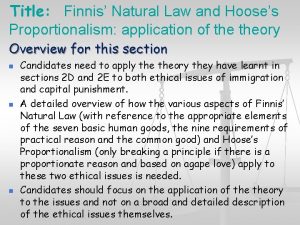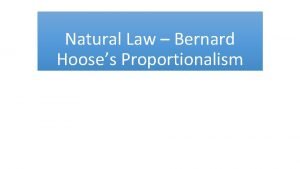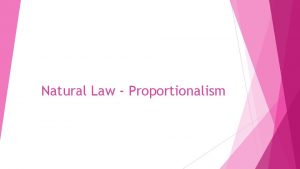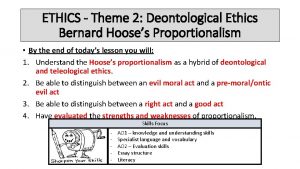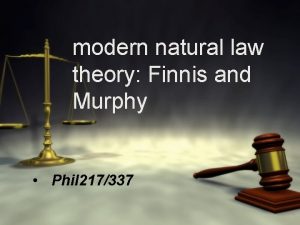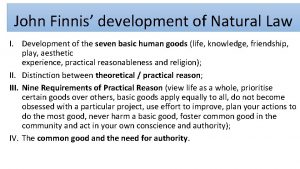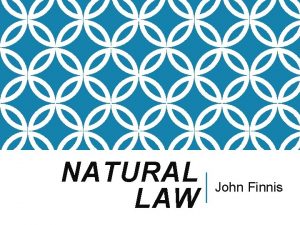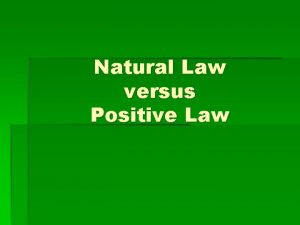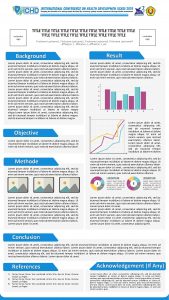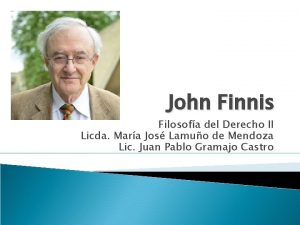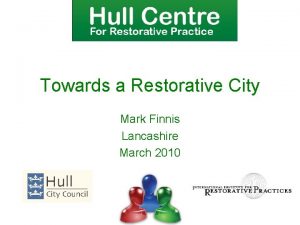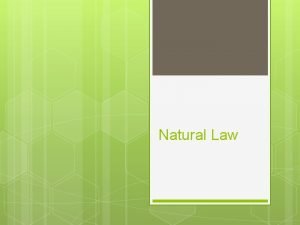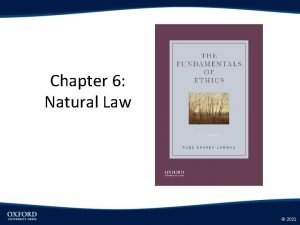Title Finnis Natural Law and Hooses Proportionalism application



























![Exam question Explain how Finnis’ Natural Law would apply to immigration [20] ■ Is Exam question Explain how Finnis’ Natural Law would apply to immigration [20] ■ Is](https://slidetodoc.com/presentation_image/0288c9c3584b6b4a9342afe24b853a14/image-28.jpg)
- Slides: 28

Title: Finnis’ Natural Law and Hoose’s Proportionalism: application of theory Overview for this section ■ ■ ■ Candidates need to apply theory they have learnt in sections 2 D and 2 E to both ethical issues of immigration and capital punishment. A detailed overview of how the various aspects of Finnis’ Natural Law (with reference to the appropriate elements of the seven basic human goods, the nine requirements of practical reason and the common good) and Hoose’s Proportionalism (only breaking a principle if there is a proportionate reason and based on agape love) apply to these two ethical issues is needed. Candidates should focus on the application of theory to the issues and not on a broad and detailed description of the ethical issues themselves.

Revision – deontological, teleological and agape 2 D Finnis’ Natural Law Theory Write a sentence to explain natural law using the words; Aquinas, eternal, reason, God, re-establish and purpose. What is the difference between practical and theoretical reason? What did Finnis mean by selfevident? What seven basic goods did Finnis identify? L, K, F, P, A, P, R What are the nine requirements of practical reason? Whole life, no arbitrary preferences between values and people, detachment, commitment, efficiency, do good, community and conscience 2 E Hoose’s Proportionalism Why did Proportionalism develop? How can Aquinas’ Natural Law be said to have some proportionalist ideas and also to oppose it? What is Proportionalism? Complete this quote from Hoose ‘It is never right to go against a principle unless . . . What are pre-moral, ontic or physical acts and why are they relevant to Proportionalism? Why are value, disvalue, right act and good act key concepts for Proportionalists? How can Proportionalism be compared to Situation Ethics?

Immigration ■ ■ ■ What is it? Why would people immigrate? What could be some of the issues arising from immigration? What reasons can you give for immigration being a good thing? What reasons can you give for immigration being a bad thing?

What is it? ■ Immigration the action of coming to live permanently in a foreign country. ■ Emigration the act of leaving one's own country to settle permanently in another; moving abroad. ■ The difference between “immigrate” and “emigrate” is “immigrating” is the act of entering a foreign country to live while “emigrating ” is the act of leaving a country to live in another.

■ Illegal immigration (also referred to unauthorized or undocumented immigrants) ■ the migration of people across national borders in a way that violates the immigration laws of the destined country

Why would people immigrate? Push factors ■ Economic ■ ■ ■ ■ No work No resources Poor education Services that provide a longer life expectancy and life opportunities Weak infrastructure Poverty (LEDCs) Political ■ ■ ■ Government opposed to your views Dictators Seeking refuge or asylum from conflict or persecution Pull Factors ■ Economic ■ ■ ■ More jobs Resources Free and effective education Medical care High Standard of living (MEDCs) Political ■ ■ ■ Freedom of beliefs and actions Democracy that allows your views to be aired A country with a good record of Human Rights or one free of conflict

Why would people immigrate? Push factors Environmental • • Current flooding, droughts, earthquakes etc High risk of natural disasters in the future (unstable) A climate inappropriate for growing food A climate inappropriate for growing goods to export Pull Factors Environmental o o No current natural disasters Stable environment with low future risks A climate that allows food to grow A climate appropriate for growing goods to export

Issues Illegal Immigration Risking life to move ■ What is the action that is the least ‘risky’? Breaking the law ■ ■ Should the law be kept in this case? If it damages pursuits of the Basic Goods (Finnis), or creates disproportionate results in terms of agape (Hoose) is it a law we should adhere to? Funding criminal gangs to move ■ Can this sort of migration ever be moral?

Issues legal Immigration Changes in demographic and culture ■ ■ Are we undermining Basic Goods by allowing this? Is this proportionate in terms of agape? Migrant crises for the countries receiving the immigrants? ■ ■ Economic consequences Problems with demands on infrastructure ■ ■ ■ Public services: transport, education, housing, healthcare Are we undermining Basic Goods in this way? Is this proportionate in terms of agape?


Theme 2 F: Applying Finnis’ Natural Law to Immigration Questions for this lesson ■ How do the seven basic human goods apply to immigration? ■ How do the Nine Requirements of Practical Reason apply to immigration? ■ How does the Common Good apply to immigration? Starter: Consider the previous discussions, do you think Finnis’ Natural Law would say immigration is a moral act?

Starter ■ “Finnis’ Natural Law would justify immigration. ” AGREE DISAGREE

Make notes on the following: Why should we welcome immigration? ■ ■ ■ https: //www. youtube. com/watch? v=LPjzf GCh. Gl. E https: //www. youtube. com/watch? v=Y 1 sd. I Hbk. HEw https: //www. youtube. com/watch? v=7 o. Om A 09 un. RM

Case Study: Migration from Sub-Saharan Africa to Europe

Task: Use your notes to explain how Finnis’ seven Basic Goods, and Nine Requirements of Practical Reasonableness would mean immigration is moral and should be allowed

Make notes on the following: Why should we not welcome immigration? ■ ■ ■ https: //www. youtube. com/watch? v=LPjzf GCh. Gl. E https: //www. youtube. com/watch? v=1 eh. G hwfd 4 s. M https: //www. youtube. com/watch? v=f. WTO a. YKp-Aw


Task: Use your notes to explain how Finnis’ seven Basic Goods, and Nine Requirements of Practical Reasonableness would mean immigration is immoral and should not be allowed and how it could be used to show immigration is moral and should be allowed

Do you still think the same? ■ “Finnis’ Natural Law would justify immigration. ” AGREE DISAGREE

Finnis’ Natural Law ■ ■ ■ Finnis disagrees with immigration or the lack of controls on immigration. Finnis warns about the imminent demise of (European, Anglo-American) civilization posed by the aliens at the gates, people immigrating from ‘other’ countries with ‘other’ cultures and social norms He thinks Western societies are quickly going to pot, and he lays some of the blame for this on loose immigration policies. Remember at AO 2 you will get an opportunity to explain challenges to his views

Finnis’ Natural Law ■ European states in the early twenty-first century move ever more clearly out of the social and political conditions of the 1960 s into a trajectory of demographic and cultural decay, circumscription of political, religious and educational speech and associated freedoms; pervasive untruthfulness about equality and diversity; population transfer and replacement by a kind of reverse colonization; and resultant international fissiparation foreshadowing, it seems, ethnic and religious inter-communal miseries of hatred, bloodshed and political paralysis reminiscent of late twentieth century Yugoslavia’s or the Levant’s. John Finnis from his essay on the political philosophy of H. L. A. Hart

How is Finnis applying his Seven Basic Goods and Nine Requirements of Practical Reasonableness in order to show that FREE immigration should not be allowed?

Theme 2 F: Applying Hoose’s Proportionalism to immigration Questions for this lesson ■ How does Hoose’s proportionalism apply to immigration? Starter: Do you think Hoose’s Proportionalism would say immigration is a moral act?

Starter ■ “Hoose’s Proportionalism would justify immigration. ” AGREE DISAGREE

What are the costs and benefits of immigration ■ https: //www. youtube. com/watch? v=by 2 d. TCj-qdk

Proportionalism ■ ■ ■ Immigration does allow for some of the ontic (real) goods – qualities such as dignity, integrity and justice – which themselves are not moral but are desirable qualities and should be taken into account when making a moral decision. However, if immigration cause harm to others, as we have seen Finnis has tried to show, it could not be justified. All possible consequences need to be considered to decide whether or not it can be justified.

Task ■ Apply the principles of proportionalism and agape to immigration
![Exam question Explain how Finnis Natural Law would apply to immigration 20 Is Exam question Explain how Finnis’ Natural Law would apply to immigration [20] ■ Is](https://slidetodoc.com/presentation_image/0288c9c3584b6b4a9342afe24b853a14/image-28.jpg)
Exam question Explain how Finnis’ Natural Law would apply to immigration [20] ■ Is this AO 1 or AO 2? ■ What must you do? ■ Plan your DISS
 Bernard hoose
Bernard hoose What is proportionalism
What is proportionalism John finnis seven basic goods
John finnis seven basic goods John finnis
John finnis Katarzyna gromek broc
Katarzyna gromek broc John finnis
John finnis Newton's first law and second law and third law
Newton's first law and second law and third law Newton's first law of motion
Newton's first law of motion Positivism
Positivism Programl
Programl Natural law vs positive law
Natural law vs positive law Natural law vs positive law
Natural law vs positive law Natural law vs positive law
Natural law vs positive law Natural law vs positive law
Natural law vs positive law Natural law vs positive law
Natural law vs positive law Prefatory elements
Prefatory elements V=k/p
V=k/p Charles law constant
Charles law constant Title title
Title title Natural income
Natural income Human nature and natural law
Human nature and natural law Summary of natural law
Summary of natural law Divine law
Divine law Application of gis in natural resource management
Application of gis in natural resource management Natural hazards vs natural disasters
Natural hazards vs natural disasters Raoult's law and dalton's law
Raoult's law and dalton's law What is a civil law
What is a civil law 4-7 the law of sines and the law of cosines answers
4-7 the law of sines and the law of cosines answers Introduction of distillation
Introduction of distillation
